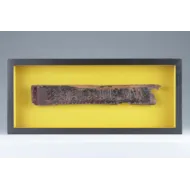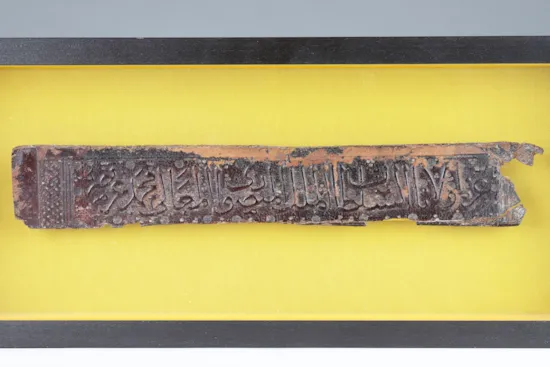Ancient Islamic Mamluk Egyptian Calligraphic Embossed Leather Book Spine
An Ancient Islamic Mamluk Egyptian Calligraphic Embossed Leather Book Spine Reading ‘Glory To Our Lord The Sultan Al Malik Al Mansur The Eminence Mohammed May His Victory Be Glorified’
14th Century / Circa 1361 - 1363
Size: 3.5cm high, 23cm wide - 1½ ins high, 9 ins wide / 13.5cm high, 31.5cm wide, 5cm deep - 5¼ ins high, 12½ ins wide, 2 ins deep (box frame)
14th Century / Circa 1361 - 1363
Size: 3.5cm high, 23cm wide - 1½ ins high, 9 ins wide / 13.5cm high, 31.5cm wide, 5cm deep - 5¼ ins high, 12½ ins wide, 2 ins deep (box frame)
An Ancient Islamic Mamluk Egyptian Calligraphic Embossed Leather Book Spine Reading ‘Glory To Our Lord The Sultan Al Malik Al Mansur The Eminence Mohammed May His Victory Be Glorified’
14th Century / Circa 1361 - 1363
Size: 3.5cm high, 23cm wide - 1½ ins high, 9 ins wide / 13.5cm high, 31.5cm wide, 5cm deep - 5¼ ins high, 12½ ins wide, 2 ins deep (box frame)
14th Century / Circa 1361 - 1363
Size: 3.5cm high, 23cm wide - 1½ ins high, 9 ins wide / 13.5cm high, 31.5cm wide, 5cm deep - 5¼ ins high, 12½ ins wide, 2 ins deep (box frame)
In the arts of the Islamic book, the script has been admired from the earliest times for its inherent aesthetic qualities. No other culture in the world has produced so many bibliophile rulers. Numerous legends abound of Princes and potentates who having killed thousands spared the calligraphers and illuminators and carried off a magnificent library of books in triumph.
Mosques and Madrasas also had their own book collections and employed calligraphers, painters and book binders. The binding of a book took on a special form in the Islamic world extending the back with a flap that could be bent around the fore edge and in under the front cover. This protected it entirely except on the top and bottom edges. In early manuscripts the covers were usually of wood covered with elaborately tooled leather. Brown leather was the material most commonly used which could be embellished with blind tooled decorations, embossed or stamped and gilded.
Mosques and Madrasas also had their own book collections and employed calligraphers, painters and book binders. The binding of a book took on a special form in the Islamic world extending the back with a flap that could be bent around the fore edge and in under the front cover. This protected it entirely except on the top and bottom edges. In early manuscripts the covers were usually of wood covered with elaborately tooled leather. Brown leather was the material most commonly used which could be embellished with blind tooled decorations, embossed or stamped and gilded.
Ex Private UK collection acquired Sothebys, October, 2007
Ex Private UK collection
Ex Private UK collection
Ancient Islamic Mamluk Egyptian Calligraphic Embossed Leather Book Spine






